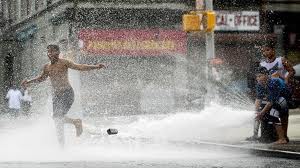How to Keep Yourself Cool When Training And Racing In The Heat
 When you do a fall marathon, the majority of the training is in the dog days of summer which are right upon us. Furthermore, the race you are doing may be known to have very unpredictable weather. So while it’s hard to predict what the weather will be like on your race day, hot weather is much more of a performance inhibitor than cold weather.
When you do a fall marathon, the majority of the training is in the dog days of summer which are right upon us. Furthermore, the race you are doing may be known to have very unpredictable weather. So while it’s hard to predict what the weather will be like on your race day, hot weather is much more of a performance inhibitor than cold weather.
So what should you do?
First and foremost, it’s very important to understand what is happening to your body from a physiological standpoint when running in the heat so that you can adapt and change things during your run depending on what your body is telling you.
When it is hot out, you sweat but your body also pumps oxygenated blood away from your inner organs and towards your skin. Your blood is then cooled due to the cooling affect that sweat has on the skin’s surface. This cooled blood then returns to the heart and inner organs to regulate your body’s temperature. The primary thing to understand is because you are generating heat when exercising coupled with the fact that the ambient temperature is also hot, your body will continue to prioritize pumping blood to the skin’s surface over pumping blood to your stomach, intestines, and internal organs.
This is important to understand because your body pumps a greater percentage of your blood to the skin’s surface during hot weather than during cold weather and this will affect how quickly (and sometimes even how completely) you can digest the fuel (gels, banana, etc.) you are taking during your hot runs. Heat can cause you to have a bloated feeling, your stomach and digestive tract can get backed up and not empty out, and it may even cause you to not want any more gels, bananas, etc.
While there are many things to consider when running in the heat, the three most important things to remember are:
- Stay hydrated as this will, among other things, maintain good blood pressure, optimizing your body’s temperature regulation system described above.
- Take the same amount of fuel each hour but in less quantities and more frequently. For example, instead of taking one gel every hour, take ½ gel every 30 minutes. This will help your stomach and intestines digest the fuel you provide it with less blood that it has available to do the work. If your stomach is still not digesting everything well, reduce your hourly intake of fuel.
- If you begin to have any of the following symptoms, it is extremely important to seek medical attention immediately: you become dizzy or disoriented, you stop sweating, or you become cold.
Heat can be uncomfortable and even dangerous to run in, but if you listen to your body and understand what it is telling you; you can safely train in the heat.
